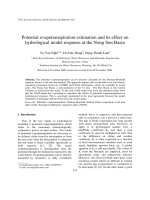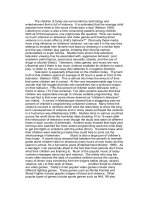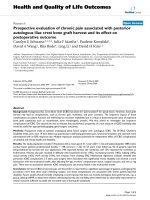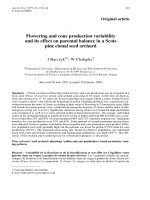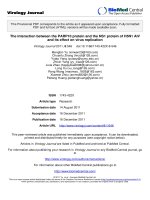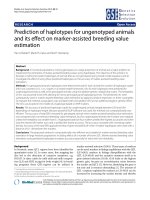DSpace at VNU: Potential evapotranspiration estimation and its effect on hydrological model response at the Nong Son Basin
Bạn đang xem bản rút gọn của tài liệu. Xem và tải ngay bản đầy đủ của tài liệu tại đây (1.68 MB, 11 trang )
VNU Journal of Science, Earth Sciences 24 (2008) 213-223
Potential evapotranspiration estimation and its effect on
hydrological model response at the Nong Son Basin
Vu Van N ghi1’*, Do Duc Dung2, Dang Thanh Lam2
' State Key Laboratory o f Hydrology, Water Resources and Hydrauỉic Engineering,
Hohai ưniversity, China
2 Southern Institute fo r Water Resources Planning, Ho Chi Minh City
Received 4 November 2008; received in revised fonn 28 November 2008.
Abstract. The potential evapotranspưation can be dứectly calculated by the Penman-Monteith
equation, known as the one-step method. The approach requừes data on the land cover and relatedvegetation parameters based on AVHRR and LDAS iníbrmation, which are available in recent
years. The Nong Son Basin, a sub-catchment of the Vu Gia - Thu Bon Basin m the Central
Vietnam, is selected for this study. To this end, NAM model was used; the obtained results show
that the NAM model has a potential to reproduce the eíĩects of potential evapoữanspừation on
hydrological response. This is seemingly imnifesteđ in the good agreement between the model
simulation o f discharge and the observed at the sứeam gauge.
Keywords: Potentíal evapotranspừation; Penman-Monteith method; Piche evaporation; Leaf area
index (LAI); Normalized diíĩerence vegetation index (NDVI).
1. Introduction
methođ, but it is expensive and thus practical
only in researches over a plot for a short time.
The pan or Piche evaporation has long records
One o f the key inputs to hydrological
with dense measurement sites. However, to
modeling is potential evapotranspiration, which
apply it in hydrological models, fĩrst, a
refers to the maximum meteorologically
pan/Piche coeíĩicient Kp, and then a crop
evaporative power on land surface. Two ldnds
coeíĩicient Kc must be multiplied as well. Due
o f potential evapoừanspiration are necessary to
to the difference on sitting and weather
be deíĩned: either from the interception or from
conditions, Kp is often expressed as a íunction
the root zone when thẻ interception is exhausted
o f local environmental variables such as wind
but soil water is freely available, speciíĩcally at
field capacity
[11, 32]. speed,
The huxnidity,
actual upwind fetch, etc. A global
equation o f Kp is stíll unavailable. The values of
evapotranspiration is distinguished from the
Kc
from the literature are empirical, most for
potential through the limitations imposed by the
agricultural crops, and subjectìvely selected.
water deíìcit. Evapotranspiration can be dứectly
Moreover, the observed Piche data show some
measured by lysimeters or eddy correlation
erroneous results which are diíTicult to explain
[4], and the pan evaporameter is considered to
CoiTesponđing author. Tcl.: 0086-1585056977.
be ừiaccurate [8, 10]. On the other hand, a great
E-mail:
v.v. Nghi et a i / VNU Ịoumal o f Science, Earth Sàences 24 (2008) 213-223
214
number o f evaporation models has been
developed and validated, from the single
climatic variable driven equations [29] to the
energy balance and aerodynamic principle
combination meửiods [23]. Among them,
probably the Penman equation is the most
physically sound and rigorous. Monteith [20]
generalized the Penman equation for waterstressed crops by introducing a canopy
resistance. Now the Penman-Monteith model is
widely employed.
As a result, in this study the PenmanMonteith method is selected to compute
directly potential evapotranspiration according
to the vegetation dataset at 30s resolution based
on AVHRR (Advanced Very High Resolution
Rađiometer)
and
LDAS
(Land
Data
Assimilation System) iníormation for the Nong
Son catchment. To assess the suitability o f this
approach, the conceptual rainfall-runoff model
kxiovvn as NAM [8] is used to examine its eíĩect
on hydrological response.
2. Potential . evap o tran sp iratio n
description
model
2.1. Penman-Monteith equation
- G ) + P.c.
(e, ~ ea)
( 1)
ẢE T =
The
Penman-Monteith
approach
as
formulated above includes all parameters that
govem energy exchange and corresponding
latent heat flux (evapotranspiration) from
uniíbrm expanses of vegetation. Most o f the
parameters are measured, or can be readily
calculated from weather data. The equation can
be utilized for the direct calculation of any crop
evapotranspiration
as
the
surface
and
aerodynamic resistances are crop specific.
2.2. Factors andparam eters determining E T
2.2.
A +ỵ
where ET is the evapotranspiration rate (mm.d'
'), Á is the latent heat o f vaporization (= 2.45
MJ.kg '), R„ is the net radiation, G is the soil
heat flux (with a relatively small value, in
general, it may be ignored), e, is the saturated
vapor pressure, e„ is the actual vapor pressure,
(e, - ea) represents the vapour pressure deíĩcit o f
the air, Pa is the mean air density at constant
Ị. Land surface resistance parameterừation
a. Aerodynamỉc resistance
The rate o f water vapor transíer away from
the ground by turbulent diffusion is conừolled
by aerodynamic resistance ra, (s.m'1) which is
inversely proportional to wind speed and
changes with the height o f the vegetation
covering
ĩring the ground, as:
_
Potential evapotranspiration can be calculated
directly with the Penman-Monteith equation [3]
as follows:
AK
pressure, Cp is the speciíic heat o f the air (= 1.01
ld.kg'1 K '1), A represents the slope o f the
saturation
vapour
pressure
temperature
relationship, ỵ is the psychrometric constant, and
r, and ra are the (bulk) suríầce and aerodynamic
resistances.
lnKZ« ~ d )Ị 2o M { Ze
(2)
where zu is the height o f wind measurements
(m); zt is the height o f humidity measurements;
d is the zero plane displacement height (m); zom
is the roughness length goveming momentum
transfer (m); zoh is the roughness lengứi goveming
ừansfer o f heat and vapour (m); U j is the wind
speed; and K is the von-Karman constant (=
0.41).
M any studies have explored the nature of
the wind regime in plant canopies. d and zom
have to be considered when the suríace is
covered by vegetation. The factors depend upon
tìie crop height and architecture. Several empirical
equations [6, 12, 21, 31] for estimating d, zom
and z0)ị have been developed. In this study, the
V. V. Nghi et aỉ. / V N U Ịoum al o f Science, Earth Sciences 24 (2008) 213-223
estimate can be made o f ra by assuming [5] that
zom = 0.123 hc and zoh = 0.0123 hc, and [21] that
d = 0.67 hc, where hc (m) is the mean height of
the crop.
b. Surface resistance
The "bulk" surface resistance describes the
resistance o f vapor flow through transpưing
crop and evaporating soil suríace. Where the
vegetation does not completely cover the soil,
the resistance íactor should indeed include the
effects o f the evaporation from the soil surface.
If the crop is not transpinng at a potential rate,
the resistance depends also on the water status
o f the vegetation. An acceptable approximation
[1, 3] to a much more complex relation o f the
surface resistance o f fully dense cover
vegetation is:
where r/ is the bulk stomatal resistance o f the
well-illuminated (s.m '1), and LAIactìve is the
active (sunlit) lea f area index (m2 leaf area over
m2 soil suríace).
A general equation for LAIactivt is [2,16, 30]:
LAỈacll„ = 0 .S L Ả l
(4)
The bulk stomatal resistance r/ is the
average resistance o f an individual leaf. This
resistance is crop specific and differs among
crop varieties and crop management. It usually
increases as the crop ages and begins to ripen.
There is, however, a lack of Consolidated
iníbrmation on changes in r, over the time for
diíĩerent crops. The iníbrmation available in the
literature on stomatal resistance is often oriented
towards physiological or ecophysiological
stuđies. The stomatal resistance is iníluenced by
climate and by water availability. However, the
iníluences vary from one crop to another and
diíĩerent varieties can be affected differently.
The resistance increases when the crop is water
stressed and the soil water availability limits
crop evapotranspưation. Some studies [14, 15,
19, 33] indicate that stomatal resistance is
215
iníluenced to some extent by radiation intensity,
temperature and vapor pressure deficit.
If the crop is amply supplied with water, the
crop resistance rs reaches a minimum value,
known as the basis canopy resistance. The
transpiration of the crop is then maximum and
referređ to as potential ừanspiration. The
relation between r, and the pressure head in the
root zone is crop dependent. Minimum values
o f rs range from 30 s.m '1 for arable crops to 150
s.m'1 for forest. For grass a value o f 70 s.m '1 is
often used [10]. It should be noted that r, cannot
be measured directly, but has to be derived
from the Penman-Monteith formula where E T is
obtained from, for example, the water balance o f
a lysimeter.
The Leaf Area Index (LAI), a dimensionless
quantity, is the leaf area (upper side only) per
unit area of soil below it. The active LAI is the
inđex of the leaf area that actively contributes to
the surĩace heat and vapor transfer. It is
generally the upper, sunlit portion o f a dense
canopy. The LA I values for various crops differ
widely but values o f 3-5 are common for many
mature crops. For a given crop, the green LA I
changes throughout the season and normally
reaches its maximum beíore or at flowering.
L Ả I further depends on the plant density and the
crop variety. Several studieđ and empirical
equations [19, 31] for the estimate of L A I have
been developed. If hc is the mean height o f the
crop, then the L A Ỉcsn be estimated by [1]:
L A l = 2Ahc
L A I = 5.5 + 1.51n(/tc)
(clippedgrassw ith0.05< hc <0.15m )
(alfalfaw ith 0 .1 0 < h c <0.50m )
As an altemative, ứie spectral vegetation
ừidices from satellite-based specừal observations,
such as ND VI (normalized diíĩerence vegetation
index), or simple ratio (SR = (1 + NDV.7)/(l NDVI)); are widely used to extract vegetation
biophysical parameters of which L A I is the
most important. The use o f monthly vegetation
index is a good way to take into account the
v.v. Nghi et al. / V N U Ịoum al o f Science, Earth Sáences 24 (2008) 213-223
216
phenological development o f the LAI, as well as
ửie eíĩects o f prolonged water stresses that reduce
the LAI [18]. In this study, ửie monthly maximum
composite 1-km resolutíon NDVI dataset obtained
from NOAA-AVHRR (National Oceanic and
Atmospheric Administration - Advanced very
High Resolution Radiometer) in 1992, 1995,
and 1996 years were used to estimate LAI. The
simple relationships between LA I and ND VI
were taken from SÌB2 [25]. For evenly
distributed vegetation, such as grass and crops:
LA I = LAI.
l n ( l - F P / 4/?)
ln (l- F P A R j ) '
(6)
For clustered vegetation, such as coniferous
ừees and shrubs:
LAI =
LAI__FPAR
(7)
where FPAR is the fraction o f photosynthetically
active radiation absorbed by the canopy, which
is calculated as:
F P A R __
S L .- S S U
,(B)
2.2.2. Surface exchanges
a.
The saturated vapor pressure is related to
temperature; if e, is in kilopascals (kPa) and T is
in degrees Celsius (°C), an approximate
equation is [28]:
es =0.6108exp
L A I -_ạ . Fci)ÍAJm^
' 17.277
,237.3 + 7 7
A=
4098e
- ■
(237.3+ r )
(9)
^ laít
!:par
fpar^
where Fd is the íraction o f clumped vegetation
in ứie area.
(11)
The relative humidity (RH %) expresses the
degree o f saturation o f the air as a ratio o f the
actual (ea) to the saturation (es) vapor pressure
at the same temperature (7):
/ ^ = 100^.
e.
( 12)
Sensible heat
The d en sity o f (m oist) air can b e calculated
from ứ ie ideal gas law s, but it is adequately
estim ated ữ om :
Pa =3.486-
1----->
(13)
275 + T
where p is ứie atmospheric pressure in kPa.
Assuming 20°c is the Standard temperature of
atmosphere, p as a íunction of height z (in
meters) above the mean sea level can be
employed to calculate by:
^ Ị Q U ^ 293 - 0 0065* ) " * .
ln (l - FPARmix )
( 10)
It is important in building physically based
models o f evaporation that not only e, is a
known íunction of temperatiưe, but so is A
(kPa.C'1), the gradient o f this íunction, de/dT .
This gradient is given by:
b.
where P P A R ^ and FPARmin are taken as 0.950
and 0.001, respectively.
and SRmn are SR
values coưesponding to 98 and 5% o f NDVI
population, respectively.
Land cover classes o f needleleaf dcciduous,
evergreen and shrub land thicket are treated as
clumped vegetation types [24]. In thc cases,
where there is a combination o f clustered and
evenly distributed vegetation, L A I can be
calculated by a combination o f equations (6)
and (7):
Saturated vapor content o f air
c.
(14,
Psychrometric constant
The psychrometric constant Y (kPa
given by:
CBP
Y = - £ - = 0.665 Xl0-3p ,
eX
0c ')
is
(15)
V. V. Nghi et al. / V N U Ịoum al o f Science, Earth Sáences 24 (2008) 213-223
where E is the ratio the molecular weights of
water vapor and dry air, equals to 0.622. Other
parameters in the equation are deíĩned above.
2.2.3. Radiation balance at land surface
In the absence of restrictions due to water
availability at the evaporative surface, the amount
of radiant energy captured at the earth’s surface
is the dominant control on regional evaporation
rates. As a monthly average, the radiant energy
at the ground may be the most “portable”
meteorological variable involved in evaporation
estimation, in the sense that it is driven by the
astronomical rather than the local climate
conditions. Understanding the suríace rađiation
balance, and how to quantiíy it, is thereíore crucial
to understanding and quantiíying evaporation.
217
following empirical relationship:
s.=
(17)
where So is the exừaterrestrial radiation (MJ.m'2
.day'1); as is the fraction of So on overcast days
(n = 0); (as + bs) is the íraction o f So on clear
days (for average climates a, = 0.25 and bs =
0.50); n is the bright sunshine hours per day (h);
N is the total day length (h); and n/N is the
cloudiness fraction. The values of N and So for
different latitudes are given in various
handbooks [3, 10].
b. Net long wave radiation
The exchange o f long wave radiation L„
(MJ.m'2.day ') between vegetation and soil on
the one hand, and atmosphere and clouds on the
other, can be represented by the following
radiation law [3, 10, 17]:
\ = ơỊo.9-^- + 0. ìẶ 0.34-0. 14^/ếTj( !T+273)4(18)
where ơ is the Stefan-Boltzmann constant
(4.903 xlO'9 MI.m^.K^.day"1).
c. N et radiation
The net rađiation R„ is the diíĩerence
between the incoming net short wave radiatíon
s„ and the outgoing net long wave radiation Ln:
Short-wave (solar) radiation
Long-wave radiation
Fig. 1. Radiation balance at the Earth's surface.
a. Net short wave radiation
The net short wave radiation s„ (MJ.m'2.day'')
is the portion o f the incident short wave
radiation captured at the ground taking into
account losses due to reílection, and given by:
5n = 5 , ( l - a ) ,
(16)
where a is the reĩlection coefficient or albedo;
and s, is the solar radiation (MJ.m'2.day'‘).
The values o f albedo for broad land cover
classes are given in various scientiíìc
literatures. The solar radiation Si (MJ.m'2.day ')
in most o f the cases can be estimated [7] from
measured sunshine hours according to the
K = s n-L„
(19)
ư sing the indicative values given in the
previous sections, for general purposes when
only sunshine, temperature, and humidity data
are available, net radiation (in MJ.m'2.day ') can
be estimated by the following equation:
R = 0.25 + 0 . 5 - 5 . - 0.90.9— + 0.1
l
n ) 0 t
N
(20)
( 0 .3 4 - 0 .1 4 7 ^ ) ( r + 273)4ơ
3. S tudy area an d d ata Processing
3.1. Study area description
The study area (14°4r-15°45’N and
107°40M 08o20’E) covers 3,160 km2 with the
218
v.v. Nghi et al. / VN U Ịounutl o f Science, Earth Sciences 24 (2008) 213-223
gauging station at Nong Son. It is a mountainous
sub-basin o f the Vu Gia - Thu Bon Basin
located in the East o f Truong Son mountain
range ÚI the Central Vietnam (Fig. 2.a). The
altitude ranges from several meters to 2,550 m
above the sea level (data derived from DEM
90x90 m). The mean slope and the river network
density o f the basin are 24.2% and 0.41 km/km2
respectively. The main suríace materials in the
basin are granite, and granodiorite bed rocks,
deluvial, alluvial sand - silt - clay deposit.
In the study area, there are only four rain
gauges, among those only One collects hourly
data; One climatic station at Tra My; and one
discharge gauge at Nong Son. In general, the
hydro-meteorological station network is poorly
(a)
Fig. 2. Nong Son catchment (a), and land
For seasonal rainfall distribution, the
rainfall in October and November reaches up to
1,800 mm. The period o f the north-east wind
lasts from Septcmber to December, coinciding
with ứie rainy season on the basins. Although
the rainy season only lasts just for 4 months, it
contributes 70% of the annual rainfall.
distributed since the rain gauges are installed
every 800 km2. The data were provided by the
Hydro-Meteorological Data Center (HMDC) of
the M inistry o f Natural Resources and
Environment (MONRE) o f Vietnam.
Due to the effects of predominating wind
direction (north-east in the rainy season) and
topography, rainfall in the basin is very high
and signiíĩcantly varies in space and time.
According to the rainfall records from 1980 to
2004 year, the rainfall distribution spatially
increases from the East to the West and from
the N orth to the South (the mean annual rainfall
at Tra My station is more than 4,000 mm, whereas
at Thanh My station is just more than 2,200 mm).
(b)
map from UMD 1 km Global Land Cover (b).
Furthermore, the annual rainfall also varies
from 2,417 mm (1982) to 6,259 mm (1996)
with an average value o f 3,697 mm. The annual
runoíT coeííicient (runoff / precipitation) in this
period intensively varies between 0.49 (1982)
and 0.81 (1995) with an average value of 0.73.
v.v. N ghi et al. / V N U lournal o f Science, Earth Sàences 24 (2008) 213-223
3.2. Land cover data and vegetation-relaíed
parameters
The land cover đata was obtained from
UMD lkm G lobal Land Cover (http://
w w w .geog. umd.edu/1 andcover/1km-map .html)
based on AVHRR and LDAS (Land Data
Assimilation System) iníbrmation. AVHRR
provides iníbrmation on globe land classiíìcation
at 30 s resolution [13]. Fig. 2.b shows the
vegetation classifícation at 30 s resolution for
the Nong Son catchment. In this area, there are
ten categories o f land cover in which evergreen
broadleaí occupies a largest area o f 48.7% in
219
total, followed by deciduous needleleaí: 19.3%,
wooded
grasslands:
18.0%,
deciduous
broadleaí: 4.2%, woodland: 3.3%, mixed cover:
3.2%, closed shrublands: 2.0%, open shrublands:
0.6%, grasslands: 0.4%, and crop land: 0.2%.
For each type o f vegetation in the Nong Son
catchment, the vegetation parameters, such as
minimum stomata resistance, leaf-area index,
albedo, and zeroplane displacement, are derived
from
/>HYDRO/cherkaue/VIC-NL/Veg/veg_lib; these
data are presented in Table 1.
Table 1. Vegetation-related parameters for each type of vegetation in the Nong Son catchment
V egetation classific atio n
A lb ed o
E vergreen b ro a d le a í ĩo rest
D eciduous n e e d le le a í íò rest
D eciduous b ro a d le a f ío rest
M ixed forest
W o o dland
W o o d ed g rasslan d s
C lo sed sh ru b lands
O pen sh ru b lan d s
G rasslands
C roplands
0.12
0.18
0.18
0.18
0.18
0.19
0.19
0.19
0 .20
0 .1 0
M inim um stom a
resistance (s/m )
250
125
125
125
125
135
135
135
120
120
3.3. Meteorological data
In the Penman-Monteith method, the
meteorological data, such as mean temperature,
relative humidity, sunshine hour, and wind
speed, are required. The observed data from the
Tra My climatic station for the period o f 19802004 were used in this study.
- Air temperature (7): The research basin is
located in the monsoon tropical zone. Based on
the data at Tra M y station, it shows an average
annual temperature o f 24.5°c. The average
lowest temperature during December-February
ranges from 20 to 22°c with an absolutely
minimum o f 10.4°c, and the average highest
temperature during a long period (April to
September) ranges from 26 to 27°c with an
absolutely maximum value o f 40.5°c.
- Relative humidity (RH): The study area
lies in a mountainous tropical humidity zone,
L e a f area
index
3 .4 0 -4 .4 0
1 5 2 -5 .0 0
1 .5 2 -5 .0 0
1 .5 2 -5 .0 0
1.5 2 -5 .0 0
2 .2 0 -3 .8 5
2 .2 0 -3 .8 5
2 .2 0 -3 .8 5
2 .2 0 -3 .8 5
0 .0 2 -5 .0 0
R oughness
length (m )
1.4760
1.2300
1.2300
1.2300
1.2300
0.4950
0.4950
0.4950
0.0738
0.0060
Z ero-plane
displacem ent (m)
8.040
6.700
6.700
6.700
6.700
1.000
1.000
1.000
0.402
1.005
and as such the value of relative humidity is
fairly high and stable with an average value of
87%. The observed data show that the
maximum humidity is observed in October to
December, reaching 92%, while the minimum
is observed somewhere between April and July,
getting as high as 83% or more.
- Sunshine hours (n): Because it lies in the
high rainy sub-region, the sunshine hours in the
study area are relatively lower than those in the
surrounding areas with a mean annual value of
5.1 hours/day. The monthly average of sunshine
hours varies from 2.0 hours/day in December to
7.0 hours/day in May.
- Wind speed and dừection («): The popular
directions o f wind are south-east and southwest from May to September, east and northeast from October to April. The wind speed is
moderate with an average annual value of 0.9 m/s.
v.v. Nghi et al. / VNU Ịoum al o f Science, Earth Sciences 24 (2008) 213-223
220
4. Results and discussion
From the land cover data and vegetationrelated parameters in the Nong Son catchment,
and the monthly meteorological data at the Tra
My climate station for the period of 1980-2004,
the potential evapotranspiration values were
determined by using the Penman-Monteith
model. Table 3 and Fig. 3 show the calculation
results o f monthly potential evapotranspiration.
Table 2. Monthly average meteorological characteristics in the Nong Son catchment
Characteristics
Tị°C)
RH (%)
n (hours/đay)
u (m/s)
Jan
20.6
89.4
3.5
0.8
Feb
21.9
87.6
4.7
1.1
Mar
24.0
84.6
5.9
1.0
Apr
26.2
82.8
6.5
0.9
May
26.9
84.1
6.9
0.8
Jun
27.1
83.8
6.6
0.8
Jul
27.1
83.4
6.7
0.8
Aug
26.9
84.1
6.3
0.8
Sep
25.9
87.6
5.2
0.8
Oct
24.4
90.4
3.9
0.9
Nov
22.6
92.5
2.6
0.8
Dec
20.6
92.4
2.0
0.7
Ave.
24.5
86.9
5.1
0.9
Table 3. Calculated monthly mean potential evapotranspừation for each vegetatíon type
and average over basin in the Nong Son catchment
ET (rara)
Evergreen broadleaf
Deciduous needleleaf
Deciduous broadleaf
Mixed cover
Woodland
Wooded grasslands
Closed shrublands
Open shrublands
Grasslands
Crop land
Areal
Jan
56
53
53
53
53
58
56
56
63
20
56
Feb
63
56
56
56
56
68
66
66
74
9
62
Mar Apr
111
93
124
87
87
124
87
124
87
124
108 131
105 129
105 129
108 124
92
32
94
119
May
123
147
147
147
147
137
135
135
132
123
133
Jun
122
142
142
142
142
130
127
127
125
123
129
Jul
129
149
149
149
149
137
134
134
131
134
136
Aug_
123
141
141
141
141
128
126
126
125
132
129
Sep
99
108
108
108
108
106
104
105
105
101
103
Oct
75
84
84
84
84
83
81
86
86
54
79
Nov
54
55
55
55
55
59
57
62
62
22
55
Dec
47
47
47
47
47
49
48
53
53
10
48
Annual
1094
1195
1195
1195
1195
1194
1170
1186
1188
853
1144
Fig. 3. Calculated monthly potential cvapoưanspứation for each type of vegetation and average over basin in the
Nong Son catchment for ứie 1980-2004 period. Note: 2- Evergreen broadleaí; 3, 4, 5, 6 - Deciduous needleleaf,
Deciduous broadleaf, Mixed cover, and Woodland; 7 - Wooded grasslands; 8, 9 - Closed shrublands, and Open
shrublands; 10 - Grasslands; 11- Crop land; and Areal-Average potential evapotranspứation over basin.
v.v. Nghi et al. / VNU Ịoum al oịScừnce, Earth Sciences 24 (2008) 213-223
221
Table 4. Monthly mean potential evapotranspiration estimated by using the Penman-Montheith method and
Piche tube data in the Nong Son catchment for the period of 1980-2004
£7’(mm)
ETp-u
E T nZ
Jan Feb Mar Apr May Jun Jul
56 62 94 119 133 129 136
68 82 118 119 133 120 128
Based on the result o f Southern Institute of
Water Resources Research [27], the potential
evapoừanspiration was derived írom Piche tube
observation values while multiplying it by
correction factors, this is usually called ETpicheThe comparative períormance o f E T by the
Penman-Monteith method (ETp.u) and ETpiehe
during the 1980-2004 period, Table 4 shows a
relatively small difference in the annual value,
precisely less than 5%. However there is
difference in monthly đistribution, particularly
Aug Sep Oct Nov Dec Annual
129 103 79
55 48
1144
125 103 84 62 56
1198
from January to March with ETpiche > ETp.M of
about
27%.
Based
on
the
climatic
characteristics in Table 2, ETp.M shows a closer
accord with the seasonal distribution. Fig. 4
shows that ETpiche values are somewhat
unrealistic, for example, potential evaporation
in June 1985 has an average value of 7 mm/day
which is too high for any natural tropical humid
area. This result agrees with that of Nguyen [4]
that the observed Piche data often give
eưoneous outputs.
Fig. 4. Companson of monthly potentìal evapoữanspứation estìmated by the Penman-Monteith method and
Piche tube data in the 1980-2004 period.
In order to assess íurther the suitability of
ửie potential evapoứanspưation estimated dừectly
by using the Penman-Monteith method and that
derived from the Piche data, ửie NAM conceptual
model was used to simulate the hydrology of
the study area in the 1983-2003 period. The
NAM model períòrmance is evaluated with a
set of two statìstical criteria: bias and NashSutcliffe eíĩiciency coeíĩicient [22].
Table 5. Performance measures of two potentìal
evapotranspữation inputs during the simulatìon
period (1983-2003) for the Nong Son catchment
Perĩormance statistics
ETpm
3.100
Bias (%)
Nash-Sutcliíĩe efficiency, R2 0.880
ETpxkc
-2.636
0.802
Discharge simulated by using the input data
of ETpicte and ETp.si is shown as monửily
averages in Fig. 5. Períbrmance measures are
v.v. Nghi et nì. / V N U Ịourruứ o f Science, Earth Sciences 24 (2008) 213-223
222
given in Table 5. While the overall simulated
discharge with the input o f ETp.M is slightly
smaller than the observed one, in the case of
ETpiche it is the reverse. However, the overall
water balances (bias) in both cases are realistic
(less than 5%). The good thing here is that ETp.M
provides a better model performance in the term
of the Nash-Sutcliíĩe efficiency (0.880) against
that o f ETpiche (0.802) with respect to the model
simulation of the discharge at the stream gauge.
Fig. 5. Observed vs. simulated monthly discharges for the 1983-2003 period using the potential
evapotranspứation inputs of ETpiche and ETp.M.
5. Conclusions
Acknowledgcmcnts
The Penman-Monteith method was used to
compute directly the potential evapotranspiration
for the Nong Son catchment. The approach was
assessed the suitability through the hydrological
model response períormance. The result o f this
approach shows a close agreement between the
simulated and observed discharges at the stream
gauge in comparison with Piche observation.
The main conclusion here is that the PenmanMonteith evapotranspiration is more reliable
than the Piche method as well as using pan
data. Although the approach requires the data
on
land
cover
and
vegetation-related
parameters, these data are available on internet
in recent years. Hence, due to the importance of
evapotranspiration in water balance, the
Penman-Monteith method is recommended as
the sole Standard method to apply for similar
catchments.
The authors would like to thank the Danish
Hydraulic Institute (DHI) for providing the
NAM software license, and the Southern
Institute o f Water Resources for data support.
R eíerences
[1] R.G. Allen, A penm an for all seasons, Jour. o f
Irr. & D rainage Engirteering 112(1987) 348.
[2] R.G. AUen, Irrigation enginecring principles,
Utah State ưnivcrsity, Utah 12 (1995) 108.
[3] R.G. Allen, L .s. Pereira, D. Raes, M. Smith,
Crop evapotranspiration-guidelines fo r computing
crop water requirem ents, FAO Inigation and
Dráinge Paper 56, Rom e, 1998.
[4] N.N. Anh, The evaluation o f w ater resources in
the Eastem Nam Bo, Project K C 12-05, Southern
Institute for W ater R esources Planning, Ho Chi
M inh City, 1995 (in V ictnam ese).
V. V. N ghi et al. / VN U Ịoum al o f Science, Earth Sãences 24 (2008) 213-223
[5] w . Brutsaert, C om m cnts on suríacc roughness
param cters and the height o f dcnsc vegetation, J.
Meteoroỉ. Soc, Japan 53 (1975) 96.
[6] w . Brutsaert, H cat and mass transíer to and ữ om
suríaces w ith dcnsc vcgetation or sim ilar
permeable roughncss, Boundary - Layer
M eteoroỉogy 16 (1979) 365.
[7] w . Brutsaert, E vaporation into the aím osphere,
D. Reidcl Pub. C o., D ordrecht, H olland, 1982.
[8] Danish H ydraulic Institute, N A M calcuỉation
materials, H orsholm , Denm ark, 2003.
[9] Danish H ydraulic Institutc, M I K E / / , Horsholm,
Denmark, 2004.
[10] P.J.M. De L aat, H.H.G. Savenije, Principle o f
hydroỉogy, L ecturc notc, IHE, Dcfì, 2000.
[11] C.A. Federer, C .J. Vorosm arty, B. Fekete,
Intercom parison o f m cthods for potential
evapotranspiration in regional or global water
balànce models, Water Resour. Res. 32 (1996) 2315.
[12] J.R. GaiTat, B .B . Hicks, M om entum , heat and
water vapour transfcr to and from natural and
artiíìcial surface, Q uarterly Journal o f the Royal
M eteorological Society 99(1973) 680.
[13] M. Hansen, R. DeFrics, J.R .G . Townshend, R.
Sohlbcrg, G lobal land cover classification at
lkm rcsolution using a dccision trce classiíĩer,
International Jo u rn a l o f Rem ote Sensing 21
(2000)1331.
[14] p. Irannejad, Y. Shao, Description and vaỉidation
o f the atmosphere-land-surface intcraction scheme
(ALSIS) with H A PEX and C abauw data, Global
and P ỉanetary C hange 19 (1998) 87.
[15] P.G. Jarvis, The interpretation of thc variation in
leaf w atcr potential and stom atal conductance
found in canopies in the ficld, Philosophical
Transactions o f the Royal Society o f London
Series B 273 (1976) 593.
[16] H.T.H. K im ak, T.H. Short, An evapotranspiration
model for nu rscry plants grow n in a lysimeter
under field conditions, Turk J Agric For 25
(2 0 0 1)57.
[17] D.R. M aidm ent, H andbook o f hydrology,
M acGraw -Hill, New York, 1993.
[18] p. M aisongrandc, A. Ruimy, G. Dedieu, B.
Saugier, M onitoring scasonal and interannual
variations o f g ross prim ary productivity and net
ecosystem productivity using a diagnostic model
and remotely - senscd data, Tellus B 47 (1995) 178.
[19] X. Mo, s. Liu, z . Lin, w . Zhao, Simulating
temporal
and
spatial
variation
of
evapotranspiration over the Lushi basin, Jo u m a l
o f H ydrology 285 (2004) 125.
[20] J.L. M onteith, Evaporation and environm ent,
Symp. Soc. Exp. Bio.y Cam bridge ưniversity
Press, C am bridge, XIX (1965) 205
223
[21] J.L.
M onteith,
Evaporation
and
suríace
tem perature, Q uaríerỉy J o u m a ỉ o f the Royaỉ
M eteoroỉogical Society 107 (1981) 1.
[22] J.E. Nash, J .v . SutcliíTe, River flow íorecasting
through conceptual modcls, Part I: A discussion
o f principles, J. Hydrol. 10 (1970) 282.
[23] H.L. Penm an, Natural evaporation from open
water, bare soil and grass, Proc. R oyal Soc.
Londón, A 193 (1948) 120.
[24] P.J. Sellers, J.A. Berry, G.J. Collatz, C.B. Field,
F.G. Hall, Canopy reflcctance, photosynthesis
and transpiration, Part III: A re-analysis using
im proved leaf modcls and a new canopy
integration schcme, Rem ote sens. Environ. 42
(1992) 187.
[25] P.J. Sellers, s .o . Los, C.J. Tucker, c .o . Justice,
D.A. Dazlich, G.J. Colỉatz, D.A. Randall, A
revised land suríace param eterization (SiB2) for
atm osphcric GCM s, Part II. The generation o f
global íĩelds o f tCTTestrial biophysical param eters
from saleỉlite data, Joum aỉ o f Cỉimaíe 9 (19% ) 706.
[26] J.B . Stevvart, M odelling surface conductance o f
pinc íorcst, A gricuỉtural and Forest M eteoroìogy
43 (1988) 19.
[27] SW ECO International, Song Bung 4 hydropow er
prọịecty TA N0.4625-VIE, Vietnam, 2006.
[28] o . Tetens, Uber cinige meteorologische Begriffe,
z . Geophys. 6 (1 9 3 0 )2 0 3 .
[29] c . w . Thom thw aite, An approach tow ard a
rational classification o f climate, G eographicaỉ
Rev. 38 (1948) 55
[30] P.J.
Vandcrkim pen,
Esíimation
o f crop
evapotranspiration by m eans o f the Penm anM onteỉth equation, Ph.D. thesis, Utah State
ư nivcrsity, 1991.
[31] D.L. Vcrseghy, N.A. M cFarlance, M. Lazare,
C LA SS-a Canadian land suríacc schcm e for
GCM s. II. Vegetation m odef and coupled runs,
International Joum aỉ o f Climatology 13(1993) 347.
[32] C .J. Vorosm arty, C.A. Fcderer, A.L. Schloss,
Potential evaporation íunctions compared on ư s
w atersheds: possible im plications for globalscale water balancc and terrestrial ecosystem
m odeling, J. H y đ ro l 207 (1998) 147.
[33] M .c . Zhou, H. Ishidaira, H.p. Hapuarachchi, J.
M agom e, A .s. Keim, K. Takeuchi, Estim ating
potential
evapoừanspiration
using
ứie
Shuttlew orth-W allace
model
and
NOAAA V H RR
NDVI
to
feed
a
distributed
hydrological m odeling over the M ekong R iver
Basin, ĩ H y d r o i 327 (2005) 151.
